Tuesday, October 10, 2006
Off to Cappadocia!
Pronounced: Kapadokya in Turkish. The name was given to this part of the country by the Persians, and means “the land of beautiful horses.”
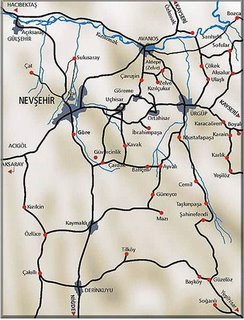
Tuesday
We all rose around 6 am to leave at 6:50 for the airport. Tired but cheerful, we boarded our bus. Flights within the country are very cheap, and the plane was booked solid. Airport security in Turkey is very tight, and we had to go through several security check-points before boarding. I think I must have something metal implanted in my body, because I set the alarms off at every check-point… We landed at Kayseri airport at 10:00 and met our tour guide, Zafir.
A little Cappadocian trivia: This region of Turkey is very arid—rain only falls two months out of the year, and has many small mountains made up of volcanic deposits. The early inhabitants found the mountains easy to tunnel in and made their homes in the caves there. Up until the 1950’s many people in Cappadocia lived in the caves, as a cave home could be purchased for several thousand dollars. They began to move out when electricity and running water became more commonly used, for it wasn’t easy to outfit a cave with the wiring and plumbing. Now, many of the caves have been bought (for quite a bit of money) and turned into hotels.
Our first stop was the Kayadam cave hotel, where we quickly stowed our luggage in our rooms. I was expecting something along the lines of the Flintstones, but this place was really lovely.
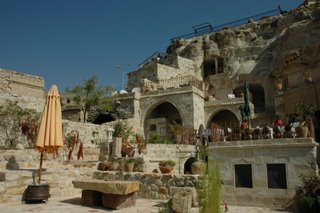
After checking in we loaded back onto the bus and headed out to see the beautiful landscape. Our first destination was the Valley of the Fairy Chimneys. These unusual rock formations were carved by a significant flood at some point in ancient history. What makes them unique is the fact that they’re topped with a “cap” of a different type of rock., and the interior of these formations are often hollow. People used to store their food in them—you can see the opening for a food-storage space in this photo. (Sam, one of the young men in our group, decided to take a personal look.)
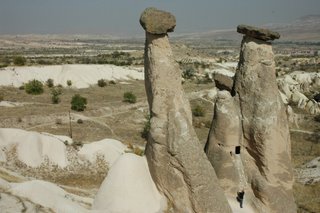
The scenery was beautiful. I kept hearing people say that it was kind of like the Southwest, but not… Zafir wanted to take us to the Cultural Folk Museum so that he could more clearly explain the life of the cave-dwellers. I had a pre-conceived notion of a rather primitive people, but learned that this ancient civilization adapted their surroundings to suit their needs. Pictured below is a re-creation of what a kitchen would have looked like for the Cappedocians.
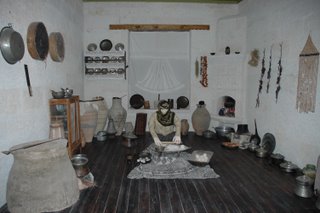
Just after the museum we ate lunch at a lovely terrace restaurant, then took a few minutes to explore the nearby shops while some of our group climbed a huge cave tower nearby.
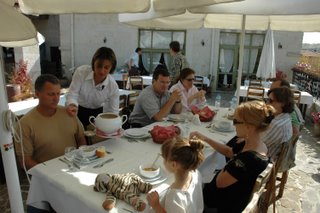
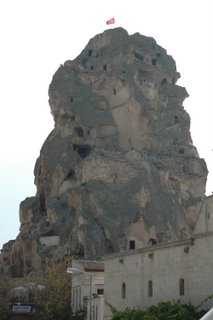 Marla climbed all the way to the top with Don and some of the guys!
Marla climbed all the way to the top with Don and some of the guys!When we’d all reassembled, it was back on the bus and off to see the cave churches. We traveled to a historical site to see the dwellings of early Christians who had carved churches into their homes. It was common for a family to gather privately for worship, and they decorated these chapels with amazing frescos. Pictured below is one of the chapels dedicated to one of the early church Fathers in this area. When the Ottomans invaded Turkey, they would often deface the frescos by scratching out the eyes.

The three fingertips touching represent the Trinity. The colors are primarily reds and golds, as the artists used plants and minerals from the area as their source for color. The three great theologians, Basil the Great, Gregory the Theologian, and Gregory of Nyssa all were born in Cappedocia and returned there in the 4th century AD. Gregory the Theologian, also known as Gregory the Great, brought monasticism to Cappedocia after spending years studying in Alexandria.
It was eerie to walk through this area where these early Christians worked and lived, and to stand quietly in a chapel, knowing that at one time this was truly a house of worship. As we drove back to our hotel, the bus was full of conversation about these people and the lives they must have lived. Tomorrow we would visit the underground cities where the Christians were forced to hide and live when the Ottomans invaded. What must that have been like—to have been forced to a life underground because of their faith?
Once back at the hotel we met on the terrace for dinner. The temperature was dropping, and we all had to bundle up. The meal was the best we’d had yet.

Crawling into bed in our cave was a truly novel experience. As we lay there we were stricken with the silence. It was so quiet. A small transom window was set into the slope of our bedroom and moonlight spilled into the cave. Very otherworldly… I could do this-- as long as there was electricity and running water.
No comments:
Post a Comment